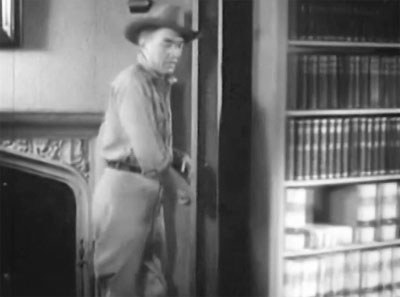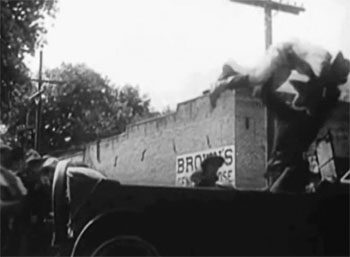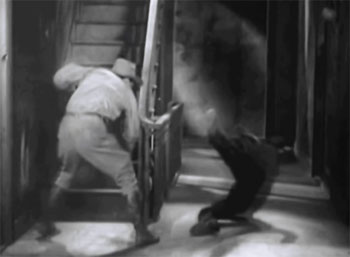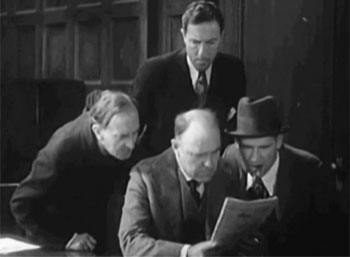
Mascot, 12 Chapters, 1931. Starring Harry Carey, Edwina Booth, Frankie Darro, Philo McCullough, Edward Hearn, Bob Kortman, Lafe McKee, William Desmond, and Rex, King of the Wild Horses.
In the Oklahoma oil country, seasoned wildcatter “Happy” Cardigan (Harry Carey) has contracted with the Milesburg Oil Company to bring in an well for a percentage of the profits, and has sunk all his savings into the project. Unfortunately for him, said project is being plagued by two different outlaw bands: the followers of a mysterious criminal called The Voice, and The Vanishing Legion–a group of night riders commanded by local rancher Stevens (Philo McCullough) and oil-company secretary Caroline Hall (Edwina Booth). The Legion and the Voice’s gang are also both bent on tracking down fugitive Jed Williams (Edward Hearn), who’s charged with murdering Stevens’ brother, the original owner of the Milesburg oil fields. In order to save his oil well, Cardigan must find out who’s really responsible for the Stevens murder and unmask the Voice, while also fighting off attacks by the latter’s henchmen and by the Legion; he receives valuable aid from Williams’ young son Jimmy (Frankie Darro) and from Jimmy’s horse Rex, a ferocious and deadly wild stallion who allows himself to be ridden by no one but his youthful master.
The storyline of The Vanishing Legion, like that of most Mascot serials, is rather over-complicated and confusing at times; however, writers Ford Beebe, Wyndham Gittens, and Helmer Bergman do a better job of avoiding illogicality than in many of their other scripts for Mascot. They keep the members of the titular Legion from doing anything that seriously contradicts the revelations concerning them in the later episodes; they also keep the various Voice suspects from engaging in pointlessly suspicious behavior (although they never explain how the guilty suspect manages to be present when the other characters are listening to radio broadcasts by the Voice). Though the mystery-villain suspects in Legion are less individualized than in some other Mascot serials (the villain candidates here consist of Stevens, the Sheriff, and the five members of the Oil Company’s board of directors), the writers make the unmasking of the culprit one of the more memorable serial sequences of its kind–complete with a Charlie-Chan-style “gathering of the suspects” and a dramatic unveiling of the guilty party (one which foreshadows the famous man-behind-the-curtain moment in Wizard of Oz).

Above: Harry Carey slides back a secret panel as he prepares to reveal the Voice in the final chapter.
Beebe, Gittens, and Bergman are also able to make their screenplay comfortably fill twelve chapters without making it too repetitious–and without resorting to the flashback sequences common in many later Mascot outings. The serial’s three principal subplots–the attacks on the oil field, the search for the Voice, and the three-cornered pursuit of Williams by the Sheriff, the Legion, and the Voice’s gang–make Legion’s narrative varied enough to stave off repetitiveness; changes in allegiance by various characters (particularly Caroline, who breaks with Stevens and leaves the Legion’s side for Cardigan’s about half-way through the serial) also help to keep the storyline fresh.
Legion’s action scenes are exciting and consistently excellent, thanks to director B. Reeves Eason and to stuntmen Cliff Lyons and Yakima Canutt (who doubles star Harry Carey). Fistfights sequences are, of course, much less slickly and precisely staged than their counterparts in later serials, but Canutt’s expertise makes them far more dynamic than the brawls featured in most contemporary Universal chapterplays. The heroes and heavies in Legion (like those in other Mascot serials) don’t merely stay on their feet and flail wildly at each other; they wrestle on the ground, flip each other around, fall down stairs, and knock each other to the floor. Some of the best bits of roughhousing include the fight between Carey and Joe Bonomo in Chapter One, the brawl between Carey and Bob Kortman in Chapter Two, and the fight at the apartment building in Chapters Eight and Nine.

 Above left: Joe Bonomo prepares to toss Yakima Canutt (doubling Harry Carey) through the air in the Chapter One fight. Above right: Canutt slugs a heavy during the apartment-building fight.
Above left: Joe Bonomo prepares to toss Yakima Canutt (doubling Harry Carey) through the air in the Chapter One fight. Above right: Canutt slugs a heavy during the apartment-building fight.
Fistfights, however, only make up a portion of Legion’s action sequences; Eason and his stuntmen also contribute shootouts, chases, and other varieties of excitement. The excellent runaway truck scene in Chapter One, with a fleet of Cardigan supply trucks running wild on a terrifyingly steep grade after their brakes have been sabotaged, is a particular highlight; the sequence makes good use of both long shots (which graphically show how far the vehicles have to fall) and closeups (which enhance the scene’s sense of headlong speed). The mass attack on Stevens’ ranch by the Voice’s gang in Chapters Nine and Ten is also extremely well-shot and well-staged; smaller-scaled, but equally good, are scenes like the Chapter Two horseback chase, the acrobatic rescue of the heroine (who’s dangling from the side of a building) at the beginning of Chapter Nine, the car/truck chase in Chapter Five, and Carey’s dramatic and dangerous attempt to ride the deadly Rex in Chapter Ten.




Above, top left and right: shots from the runaway truck sequence. Bottom left: The Chapter Nine rescue. Bottom right: Philo McCullough (left) ducks for cover as Harry Carey tosses dynamite during the battle at the ranch.
Some of the cliffhangers in Legion are comparatively mild–like the off-camera screaming by the heroine that ends two chapters in a row. However, others are visually spectacular–such as the double crash that follows the above-mentioned runaway-truck sequence and closes Chapter One, Carey’s fall from an oil derrick at the end of Chapter Four, and the double cliffhanger in Chapter Eight (which has Carey being crushed by a desk that rolls down the stairs on him, while Edwina Booth falls from the side of a building). The horse stampede through the oil-field camp at the end of Chapter Two (which makes some perceptible but smooth use of stock footage) is also memorable, as is the impressive truck crash that provides the Chapter Five cliffhanger.

Above: Our hero plummets to apparent doom down the inside of an oil derrick to close Chapter Four.
The hills and plains of Kernville furnish an appropriately rugged backdrop for most of the action, although it feels slightly odd at first to see cars and trucks roaring down the same Kernville roads traversed so frequently by horses and wagons in Universal’s period Western serials; Eason and his cameramen do a fine job of showing off the area’s panoramas to good advantage, particularly in the chases in Chapters Two and Twelve and in the shot of the Legion charging down a hillside (which is used to open each episode). The Newhall oil fields of California’s Santa Clarita region make a nicely authentic backdrop for the scenes set at Cardigan’s well.

 Above: Scenic Kernville shots from the chases in Chapters Five (left) and Two (right).
Above: Scenic Kernville shots from the chases in Chapters Five (left) and Two (right).
The characterizations in Vanishing Legion, true to Mascot form, range from floridly hammy to underplayed. Harry Carey’s strong lead performance provides a good acting anchor for the serial; he handles his dialogue in far more realistic and down-to-earth fashion than many of his co-stars. Aided by his tough voice and weather-beaten appearance, he makes his character seem exceptionally tough and doggedly determined; his gruffly ferocious manner as he confronts villains is genuinely intimidating. However, Carey isn’t unrelievedly grim; he also gives Cardigan a lighter side, interacting with Frankie Darro’s Jimmy in good-natured and kindly style, and reacting to many calamities with sardonic but appealing humor–as when he wryly wisecracks when surrounded by the Voice’s henchmen, or silently registers amused disgust at the bumbling of the Sheriff.
Edwina Booth, who had previously co-starred with Carey in MGM’s famed Trader Horn, fails to match her leading man’s charisma. Though her character–who breaks the law in what she considers to be a just cause, but rethinks her position when innocent people are endangered by her activities–is unusually complex for a serial heroine, Booth plays the potentially interesting part with very little subtlety–ranting furiously at her fellow-members of the Legion and defying the villains in highly theatrical fashion, but failing to balance these loud outbursts with any quieter displays of warmth or friendliness; when not shouting, she delivers her lines with over-dramatic breathlessness or emphatic seriousness, rarely even cracking a smile. Her character comes off as psychotic, rather than conflicted, which was surely not the idea.

Above: Edwina Booth tells off Philo McCullough.
Frankie Darro does much better as Jimmy Williams; his boyish confidence (as in his entertaining entrance scene, in which he shyly but cockily reveals his mastery of the horse Rex to a surprised group of cowboys) is appealing and comes off as utterly natural–as do his tearful reactions to the misfortunes suffered by Jimmy and his father (Darro’s heart-broken reaction to the apparent death of said father in Chapter Two is particularly moving). Darro’s equine sidekick, the aforementioned black stallion Rex, cuts an impressive figure as he gallops furiously across the range or charges down on heavies; unlike most prominently-featured serial steeds, he’s presented as a genuinely dangerous wild animal throughout the chapterplay, and menaces good guys as well as bad ones.
Philo McCullough–tough in appearance but smugly slick in manner–makes the Legion’s leader Stevens seem suitably intelligent, formidable, and enigmatic. The Voice’s gang is led by plug-ugly Bob Kortman, who snarls viciously and scowls murderously at anyone who crosses his path, and serves as a very effective action heavy. The intensely sincere but decidedly hammy Edward Hearn veers between grandiosely melodramatic grief and desperation and more restrained wariness and resignation as the much-wronged fugitive Williams; overall, his acting (unlike Edwina Booth’s) is balanced enough to be effective. William Desmond also chews the scenery as the incompetent Sheriff ; his blustery and bombastic performance seems well-suited to the character.

 Above left: Bob Kortman gloatingly explains the Voice’s plans to a roomful of henchmen; Dick Hatton is standing on the far right. Above right: Edward Hearn (standing) confronts William Desmond.
Above left: Bob Kortman gloatingly explains the Voice’s plans to a roomful of henchmen; Dick Hatton is standing on the far right. Above right: Edward Hearn (standing) confronts William Desmond.
White-haired Lafe McKee is both affable and cagey as the kindly lawyer Hornbeck, the head of the Milesburg Oil Company’s board of directors; he presides over the board’s meetings with dignity, and amusingly outmaneuvers the Sheriff in more than one legal argument. Comic character actors Frank Brownlee and Tom Dugan are hilarious as two of the other board members; the deadpan Dugan aggressively agrees with all of the opinions expressed by the other directors (even when the directors are flatly disagreeing with each other), while the boisterous and choleric Brownlee registers increasing exasperation at his colleague’s shameless toadyism. Together, the two make the board-meeting sequences far more entertaining than the serial norm. German-born actor Paul Weigel has little to do but look and sound craftily sinister as another board member, even though his character becomes pivotal to the plot in the later chapters; Robert Walker, as the fifth member of the board, has even less to do, receiving no more than a dozen lines during the course of the serial.

 Above left: Lafe McKee takes a phone call. Above right: the board of directors examine a newspaper that reports the arrest of Jed Williams. Frank Brownlee holds the paper, as Tom Dugan (with cigar), Paul Weigel, and Robert Walker (standing behind Brownlee) crowd in behind him.
Above left: Lafe McKee takes a phone call. Above right: the board of directors examine a newspaper that reports the arrest of Jed Williams. Frank Brownlee holds the paper, as Tom Dugan (with cigar), Paul Weigel, and Robert Walker (standing behind Brownlee) crowd in behind him.
Hulking silent-serial star Joe Bonomo and the somewhat furtive-looking Dick Dickinson are cast as the most prominent supporting members of the Vanishing Legion. Yakima Canutt plays more than one Legion member, while Al Taylor also does double duty (as a deputy sheriff and a Voice henchman); Cliff Lyons takes multiple bits as well. Other Voice henchmen are played by Pete Morrison, Bud McClure, Bob Reeves, and Dick Hatton (who’s put on “trial” after failing the Voice, in a memorably eerie scene). Tracy Layne is one of Harry Carey’s oil-drillers, and character actress Olive Carey–Carey’s real-life wife, billed here as Olive Fuller Golden–figures notably in the later chapters as a shady, hard-boiled nurse.
Walter Miller crisply narrates the serial’s plot recaps; another familiar voice is also present on the soundtrack–that of the pre-Frankenstein Boris Karloff, who delivers the dialogue for the mysterious Voice, but doesn’t otherwise appear in the serial. Though the Voice, unlike most Mascot mystery villains, never makes a physical appearance (instead communicating with his henchmen via pocket radios), Karloff’s hoarse but sibilant whisper gives the heavy a far more sinister presence than many of the cloaked, masked, and stentorian-voiced heavies seen in other Mascot outings. The “trial” sequence mentioned above provides the great Karloff with a particularly good vocal showcase.
The Vanishing Legion is strong in all the places one expects a Mascot Pictures serial to be strong in; its action scenes are first-rate, its location work excellent, and its performances lively. It’s also a bit less weak in the plotting department than many of the studio’s serials–which makes it, overall, a very satisfying chapterplay.



This was one of Mascot’s better serials, and with the exception of PHANTOM OF THE WEST, all of Mascot’s 1931 serial releases were winners. Best of all was THE LIGHTNING WARRIOR which was one of their top three.
While Harry Carey was a great hero, he just seemed to be too old and frail to take on Joe Bonamo in a fight.
One minor thing that bothered me about this chapter-play was Dick Hatton’s “punishment.” First off, he died in a car accident either during or shortly after production, and looks decidedly down and out and unkempt. Hard to believe that he starred in a series of westerns in the mid-1920’s.
Anyway, back to his “punishment.” Creepy and un-nerving scene, yes, but what happened to him? There is a scene shortly afterwards in that room, and there’s nothing there. No body…nothing. I realize that I have to take leaps of faith in these chapter-plays, but he just vanished and is never seen again. I’m sure one could fancifully speculate that he disintegrated or something…or perhaps, he had the car accident shortly afterwards, and Mascot just had him disappear from the film. Yes, this is nitpicky, but fun (for me, anyway) to speculate upon.
Melodramatic to be sure, but thoroughly entertaining. Great cast, interesting story, and nice locations all make for a first rate chapterplay. Mascot definitely delivered the goods with this one.
On a side note – this first time that I viewed this serial, it was the “original”, unedited version. At the time, I had no idea of all the controversy that had ensued regarding the “censorship” of Chapter One. For me, the scene in question played as very emotional but otherwise inoffensive. It was only later that I read some of the discussion surrounding the “questionable” content and the changes made by Serial Squadron. I decided to view the scene again, and came away with the same reaction – it was an emotional portrayal, but decidedly not offensive. A tempest in a teapot, as many fan-related disputes often seem to be.